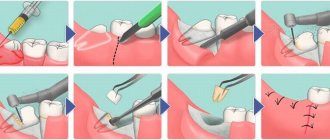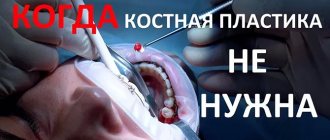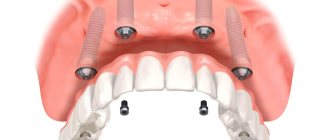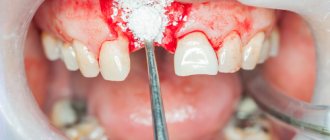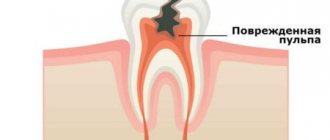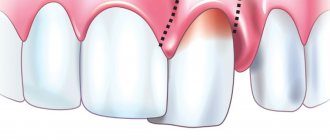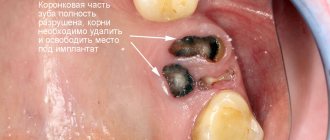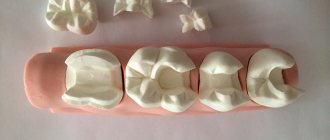More than thirty years have passed since the collapse of the Soviet Union, a lot has changed in medicine for the better, and people are still afraid to go to the dentist, remembering themselves or having heard from others how painful and unpleasant it is.
Anesthesia in Soviet dentistry was indeed a “weak link”, and many manipulations in the dentist’s chair were done without pain relief at all. However, now the situation has become much better, including thanks to the penetration of foreign drugs and technologies into our market.
The usual injection has been replaced by many different techniques. Of course, it’s still difficult to call a visit to the dentist pleasant, but it has definitely become much more comfortable.
Anesthesia
Modern anesthesia not only eliminates the patient’s physical pain during procedures, but also reduces his psycho-emotional stress - eliminates the fear of the doctor, which significantly increases the efficiency and quality of the specialist’s work.
Types of anesthesia in dentistry
Anesthesia in dentistry can be general or local. The first includes intravenous sedation, as well as general anesthesia. That is, the drugs do not act locally in the oral cavity, but throughout the entire body. Actually, this is ordinary general anesthesia, which is used everywhere in medicine - it’s just that certain types are used in dentistry. Local, as it is already becoming clear, includes the familiar “freezing”, which is administered by injection.
Separately, we can also distinguish xenon sedation or xenon therapy - the second name will be even more correct, since such anesthesia is used to prepare for local or general anesthesia. It allows you to reduce the level of anxiety and stress, saturates the body's cells with oxygen, due to which it has a general healing and even rejuvenating effect! It is not an independent type of pain relief, but is used in combination with other approaches.
Possible complications
In the practice of specialists at the World of Dentistry clinic, severe complications after conduction anesthesia occur in extremely rare cases. Negative effects include neuropathy and an inadequate response of the body to the administered drug. Complications that are normal and go away on their own include:
- Muscle weakness.
- Goosebumps effect.
- Partial loss of sensitivity.
The above symptoms disappear without a trace a maximum of a month after the procedure. Damaged nerves are completely restored.
Xenon sedation or xenon therapy to prepare for main anesthesia
This is a separate type of anesthesia that can be used in combination with both local and general anesthesia (if necessary). Xenon is an inert gas that quickly begins to act and is just as quickly eliminated from the body. It has a relaxing effect: anxiety decreases, the patient relaxes. Moreover, during the operation he is fully conscious, can communicate with the doctor, and understands everything that is happening around him. The procedure can be interrupted if necessary if there is discomfort. At the same time, local anesthetics are used, since xenon itself does not have a pronounced analgesic effect.
Among the pleasant “bonuses” are saturation of cells with oxygen and restoration of metabolic processes. That is, this is not only a reduction in stress, but also a general improvement in the body’s health.
General anesthesia in dentistry
With general anesthesia, the patient falls asleep for 1-2 hours or more, i.e. for the entire duration of treatment. The drug is administered intravenously, less often by inhalation. If possible, general anesthesia should still be avoided, since its effect on many organs is quite toxic. Even despite the fact that dentistry uses “lighter” drugs than during complex surgical operations. This is a fairly large load on the body, especially on the heart, nervous and cardiovascular systems.
Intravenous sedation
Intravenous sedation does not have such pronounced negative consequences for the body. Softer and gentler drugs are used here. Sedation puts a person into a half-asleep state - the patient can respond to the doctor’s commands, communicate and understand him. At the same time, the person is completely relaxed and may even fall asleep for several hours. Thus, intravenous sedation is a more gentle and safe type of pain relief.
This is interesting! The word “sedation” itself means “calming.” It can be carried out either by inhalation (nitrous oxide or safer and more effective xenon is used for this), as well as intravenously with the selection of drugs strictly individually.
We treat without pain and discomfort!
Intravenous sedation
Safe and pain-free Treatment in your sleep Quick recovery from RUB 8,000. from 8,000 rub.
Xenon sedation
Relaxation before treatment No stress on the body Recovery in 2-3 minutes from RUB 5,000. from 5,000 rub.
With us you will stop being afraid of dentists! Individual selection of drugs, the most modern equipment and certified doctors who professionally work with all types of anesthesia.
Enroll now
What is local anesthesia?
Local anesthesia allows you to numb the specific area where the intervention is planned. The patient is conscious. And this is actually more than enough even for complex surgical operations.
For local administration of all types of anesthetics, special reusable syringes are used, which have a recess for inserting a carpule - this is a hermetically sealed ampoule with an anesthetic. Unlike disposable ones, carpule syringes have a thinner needle, which allows you to administer the drug slowly and thus eliminate pain. All syringes for reusable use must undergo antiseptic treatment and sterilization using modern ultrasonic and temperature sterilization equipment.
The essence of Vishnevsky's method is as follows:
1. The novocaine solution (fresh, of course) is heated to body temperature; 2. Fill it into a syringe (2 ml); 3. Liquid is injected under the skin.
As a result, a so-called lemon peel should form.
Gradually they move further and infiltrate other areas.
Vishnevsky included the following substances in his solution:
- sodium chloride (5 g);
- potassium chloride (0.075 g);
- calcium chloride (0.125 g);
- distilled water (1000 ml);
- and, in fact, novocaine (2.5 g).
For example, 50 ml of anesthetic is quite enough to anesthetize the upper jaw.
Infiltration anesthesia
Classic “freezing”, which is used in dentistry for almost any manipulation. The drug is injected under the mucosa, into the periosteum or directly into the bone. Depending on the procedure and the patient’s pain threshold, the required dosage is selected - for example, in case of acute pulpitis or complex tooth extraction, a higher concentration of the drug is used. If the patient is afraid of injections, topical anesthesia can additionally be used to numb the site of needle insertion, or xenon sedation.
When performing the procedure, the doctor must take into account the anatomy of the jaw system. For example, in the lower jaw the alveolar bone is denser, so anesthesia is less effective. In the upper jaw, when performing manipulations in the area of wisdom teeth, there is a risk of the needle touching one of the branches of the facial nerve, which is fraught with the development of neuralgia. The clinic’s doctors have the necessary qualifications, so even the most complex anesthesia is performed completely safely for the patient.
Central conduction anesthesia
Pterygopalatine anesthesia involves the injection of a solution into the pterygopalatine fossa. This fossa lies between the upper jaw and the pterygoid process of the sphenoid bone. It is safer to insert a needle into the pterygopalatine fossa than into the foramen rotundum.
Possible routes of pain relief
- palatine, when the needle is inserted through the greater palatine foramen and moved along the pterygopalatine canal, numbing the maxillary nerve;
- tuberous, when the solution is released near the maxillary tubercle and along the bone;
- orbital, when the skin above the bone of the anterior wall of the lower orbital margin is pierced, the solution is injected behind it;
- subzygomatic-pterygoid, when the needle is inserted into the middle of the trago-orbital line at the lower wall of the zygomatic arch, the anesthetic is injected into the outer plate of the pterygoid process, as well as into the pterygopalatine fossa.
Another method of central conduction anesthesia is anesthesia at the foramen ovale. It is located in the medial posterior part of the infratemporal fossa. The fossa itself is a depression on the side wall of the skull.
Methods for anesthetizing the foramen ovale
- subzygomatic, when a puncture is made in the middle of the trago-orbital line, deepened to the outer plate of the pterygoid process, through which they enter the foramen ovale;
- suprazygomatic, when the needle is inserted through the trago-orbital line, deviating downwards;
- mandibular, when the needle is passed along the inner surface of the branch, the end is retracted to the bone wall;
- orbital, when the lower edge of the orbit near the inferior outer corner is pierced, the needle penetrates the infratemporal fossa through the lateral region of the inferior orbital fissure.
Preparations for local anesthesia
The Smile-at-Once clinic uses modern anesthetics of the latest generation - effective, non-toxic and absolutely safe, even for pregnant women, the elderly or children. We do not use drugs based on novocaine or lidocaine due to toxicity and a high risk of allergic reactions. In addition, the articaine group of drugs, which are used today for local anesthesia, are 5-6 times more effective than lidocaine.
"Ultracaine" for all groups of patients
An original drug produced in France, which is used for both infiltration and conduction anesthesia.
It is safe, used even in the presence of allergic reactions, and is suitable for patients with heart disease and pregnant women. Its effectiveness is very high, while it is instantly eliminated from the body and does absolutely no harm. The main active ingredient is articaine, to which epinephrine is added to enhance the anesthetic and prolong its action. It provides local vasoconstriction, which significantly shortens the rehabilitation period after treatment. Depending on the concentration of epinephrine, there are three types of the drug - for different manipulations and categories of patients.
"Ultracaine-Forte" (concentration 1:100,000) is a drug with a high dose of epinephrine, used during surgical operations. "Ultracaine DS" with a low concentration (1:200,000) - is used for therapeutic treatment, including in patients with diseases of the cardiovascular system, high blood pressure, suitable for pregnant and lactating women. Ultracaine D does not contain epinephrine. The effect of the drug is short, but it can be used for allergic reactions, bronchial asthma, and pronounced cardiovascular pathologies.
"Ubistezin"
A cheaper, but no less high-quality analogue of Ultracain, produced by the German company 3M. It contains similar active ingredients: articaine hydrochloride and epinephrine. It has two forms of release, depending on the concentration of the latter (1:100,000 or 1:200,000). Use is allowed during breastfeeding and cardiovascular pathologies.
"Artikain"
An injection solution that consists directly of the main active ingredient - articaine. Inexpensive drug made in Russia. Used for infiltration or conduction anesthesia. Can be used in pure form or with the addition of epinephrine/glucose solution in a certain proportion. Not used for bronchial asthma and severe allergic reactions.
"Scandonest" for the elderly
The main active ingredient of this French-made drug is mepivacaine hydrochloride. It is not used during pregnancy and bronchial asthma, but use is allowed in patients with cardiovascular pathologies, since the drug does not contain epinephrine, adrenaline and preservatives. Suitable for older people, especially those with high blood pressure. It is one of the safest anesthetics for both infiltration and conduction anesthesia. Its disadvantage is its short duration of action, which requires repeated administration of the drug approximately every 30 minutes during long procedures.
"Orablock"
Another drug, the main active ingredients of which are articaine and epinephrine with varying concentrations of the latter, which affects the effect and duration of pain relief. Not used during pregnancy and pronounced cardiovascular pathologies.
"Naropin" for complex surgical operations
A long-acting anesthetic whose main active ingredient is ropivacaine hydrochloride. The duration of pain relief depends on the dosage. Very often, this drug is used for conduction anesthesia during complex surgical operations and the installation of a large number of implants. Among the contraindications is only individual intolerance to amide anesthetics.
Indications and advantages of local anesthesia
Since local anesthesia is used everywhere, the indications for its use are very wide. Modern drugs are of very high quality and completely safe (especially if you use them thoughtfully, having first collected a high-quality anamnesis about the patient’s health condition). The level of stress from treatment without anesthesia, and especially with acute pain, can be prohibitive - very often after this, patients refuse to visit the dentist, causing dental problems. Do not be afraid of anesthesia - you will not receive such a “dose” of the drug that will harm you, even if you have to treat your teeth for several days in a row.
Indications for local anesthesia
- removal of dental plaque,
- dental treatment of any complexity,
- performing plastic surgery on gums,
- tooth extraction,
- surgical operations in the oral cavity,
- preparation and implementation of dental implantation.
Advantages
- complete relief of any painful sensations,
- safety, no toxic effects on the body,
- rapid elimination from the body,
- minimum side effects,
- the choice of drug based on the health status and age of the patient.
If you are planning a visit to the doctor, we advise you to observe a number of points:
- do not drink alcohol the day before, this may worsen the effect of the anesthetic;
- if you have a cold, cough, or runny nose, it is better to postpone your visit until you have fully recovered;
- Women and girls are not recommended to visit the dentist during menstruation, because... during this period, blood clotting worsens (by the way, do not be surprised if the anesthesiologist asks you this question before surgery; operations are not performed during menstruation.
- choose your clinic carefully! Now their choice is very large, but very few comply with important requirements and all antiseptic requirements!
Are there any disadvantages to local anesthesia?
Local anesthesia has virtually no disadvantages. Unlike drugs that were used previously, modern anesthetics are absolutely safe, have a minimum of contraindications, are quickly eliminated from the body, and do not have a negative effect on the heart, kidneys and liver. With professional administration, the patient will not feel any pain even during long surgical procedures.
“Our clinic uses a strictly individual approach. We have selected several of the most effective and safe drugs - for each patient we select our own method, drug and its concentration, based on individual characteristics. Therefore, everyone who undergoes treatment, implantation or prosthetics at the Smile-at-Once clinic can feel completely safe.”
Zhilenko Evgeniy Aleksandrovich, Implant surgeon, periodontist, orthopedist Work experience over 18 years make an appointment
How to treat teeth without pain?
Today, all therapeutic and surgical procedures performed by a dentist with the risk of causing pain to the patient are carried out exclusively after the use of painkillers. Dentists use different types of anesthesia, which means reducing the sensitivity of the injection site to any external influences. The administered medication prevents the “pain impulse” from entering the brain, so the person “feels nothing.” Anesthesia in dentistry is necessary so that the patient avoids unpleasant sensations when a specialist performs treatment. When the patient is not in pain, he can remain at rest for a long time. These are optimal conditions under which the dentist can perform manipulations more efficiently and effectively.
Modern technologies for administering anesthesia
The pain of the anesthesia itself, as well as its effectiveness, depend 90% on the skill of the dentist. A professional doctor will make every effort and use various techniques to make the patient feel comfortable. However, all people are different, each has their own pain threshold, and that is why an individual approach not only to the concentration of drugs, but also to premedication before the direct administration of anesthesia is very important.
Today, special anesthesia devices have been developed to help doctors. Naturally, they work under the supervision of a specialist. The electronic system is equipped with special pressure sensors - to avoid pain, the anesthetic must be injected very slowly and immediately after puncturing the tissue. The device is equipped with special needles with a very thin double tip, which again reduces pain.
In addition, by administering a small dose of anesthetic, a kind of allergy test is performed - the doctor assesses the condition of the soft mucous membranes (swelling, redness, rash) and the patient’s general reaction, and the pressure force is controlled by the device.
Safe, painless and effective treatment without pain! Treatment is carried out under the supervision of anesthesiologists capable of providing first aid. Special equipment monitors indicators of the general condition of the body.
If there is any threat, the ambulance station is 800 meters from the clinics! You are under the reliable protection of professionals.
Enroll now
The use of anesthesia for health pathologies
- diabetes mellitus, bronchial asthma, allergic reactions: anesthetics without preservatives and with a minimal amount of epinephrine are used. For these problems, medications are selected strictly individually, most often based on the results of additional tests,
- high blood pressure, heart disease: with minimal or no epinephrine. It is also important that anesthetics do not contain adrenaline. For these pathologies, intravenous or xenon sedation can be used,
- pregnancy and lactation: drugs with a low content of epinephrine - in minimal dosages, the active substance does not cross the placenta and practically does not enter breast milk (only in small quantities, but this does not have any negative effect, so after dental treatment you can not skip feeding and no need to express milk). It is important that the drugs cannot be used without the addition of the vasoconstrictor epinephrine - in this case, the vessels remain open and the active substance will quickly spread throughout the body, which increases the risk of its transmission to the fetus or child through breast milk.
Expert opinion
Emir Romanovich Omerelli
Maxillofacial surgeon, implantologist
Experience: more than 13 years
As can be seen from the above, pregnancy is a factor that excludes almost all types of anesthesia during treatment. Some experts believe that it is possible to use painkillers for dental treatment during pregnancy, but only if they do not contain adrenaline. And yet, before starting treatment with anesthesia, you need to decide whether it is really necessary in each specific case, and, if you cannot do without it, use local anesthetics. It is also worth assessing the level of necessity and appropriateness of the procedures, for example, teeth whitening is not necessary, and it is better to postpone it. There is no special anesthetic drug for pregnant women.
Currently, dentistry has a wide selection of drugs and anesthesia technologies. This allows treatment to be carried out with maximum comfort for the patient and the doctor. However, we should not forget about the risks of negative consequences, and make a decision about using anesthesia after carefully weighing all the pros and cons. Local anesthesia is by far the most preferred choice.
Other jobs
Sedation and anesthesia - is it safe?
Yes, if they are carried out by professional doctors who have extensive experience and have undergone appropriate training (and a license is also required to perform general anesthesia - this requires an anesthesiologist-resuscitator), then the procedure will be completely safe. In addition, for complex and long-term implantation, the use of sedation is even preferable - you are less tired, you do not need to focus on keeping your mouth open for several hours and fixing your head in a certain position. For you, 3-4 hours of surgery passes in an instant. You will be under the supervision of specialists, and before the operation you will undergo a fairly extensive list of tests for high-quality preparation for treatment and selection of the most suitable, safe drug.
1 Zoryan E.V. Errors and complications when performing local anesthesia in dentistry, 2007.
